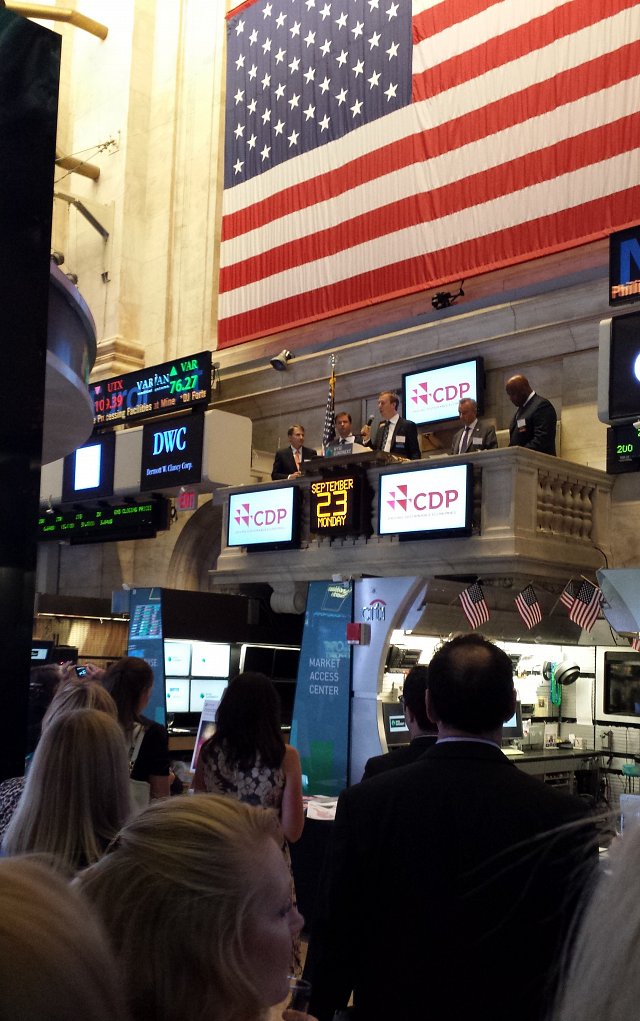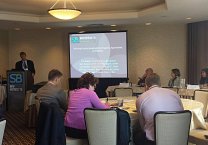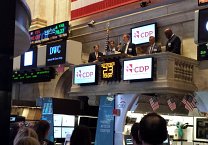Progress, Pressure, and Payback: CDP’s 2013 Annual Report Launch
by Bryan Sheehan
27 September 2013
There was a palpable energy on the floor of the New York Stock Exchange among the business leaders, NGO representatives,  investors, consultants, and media in attendance at the launch event for CDP's 2013 S&P500 Climate Change Report.1 As one of CDP's U.S. consulting partners, Pure Strategies attended this exciting launch event.
investors, consultants, and media in attendance at the launch event for CDP's 2013 S&P500 Climate Change Report.1 As one of CDP's U.S. consulting partners, Pure Strategies attended this exciting launch event.
The first spark of energy came from the uniqueness of meeting in what is arguably the heart of the world's investment community. Five years removed from the 2008 market meltdown, much work remains to fully secure the 'financial responsibility' part of a truly sustainable society. Investors have a key role to play in sustainability however, evidenced by the 722 global investors totaling $87 trillion in assets (five and a half times U.S. GDP) that CDP represents.
Exciting progress
One of the most exciting and energizing aspects of the evening was hearing about some of the encouraging progress that has been made:
- Over 1,000 U.S. companies report to CDP, including two-thirds of the S&P 500, representing 30% of total U.S. emissions.
- Companies reported a 6% emissions reduction from 2012 to 2013, while the S&P500 and U.S. GDP grew by 15.8% and 2.8%, respectively.
- 75% of S&P 500 CDP reporting companies have set and publicly disclosed direct and indirect emissions reduction targets; over 50% have met or are on track to meet them.
- 78% of reporting companies see business opportunities related to addressing sustainability issues – up from 59% in 2012.
Increasing pressure to do more
The milestones that have been achieved are important and deserve to be celebrated, but there was also a sobering recognition that much more still needs to be done. More companies are reporting detailed information and greater commitments, but many more still need to do the same. Many companies are showing they can grow while reducing absolute emissions, but to support a planet of nine billion people, all will need to re-think how to drastically reduce emissions and eliminate waste.
77% of responding companies report significant business risks due to climate change, and 63% said they expected to experience these risks in the next 1-5 years.We see continuing manifestation of these risks, from storms and floods to droughts and wildfires, to customer and other stakeholder pressures. It seemed that everyone in attendance had a strong sense of urgency about determining the best way to continue to reduce business risk and adverse impacts in ways that align with their companies' core goals.
Real, near-term payback
But I sensed yet another source of energy: the energy of opportunity. Perhaps heightened by being on the floor of the NYSE, where looking for the next great investment is instinctive, there was broad recognition that businesses are reaping real and near-term financial and competitive rewards for their sustainability efforts:
- Companies with higher CDP disclosure scores on climate change engagement generate higher return on equity, more resilient cash flow, and stronger dividend growth than their industry peers.
- 79% of S&P500 CDP respondents generate higher returns on their emissions-reduction activities than the average return on investments in their core business.
- 69% of the investment projects cited by reporting companies fall within a 3-year payback horizon.
You can't earn the reward, if you don't make the investment
- If your company is not reporting to CDP, it would be wise to start. Doing so can help expose risks and opportunities, and ensure your business a spot among this group of recognized leaders.
- If your company is reporting to CDP, ensure you are not just 'checking the box.' Use the process and the insight it reveals to inform a company-wide sustainability strategy that aligns with your core business goals. Nearly 60% of reporting companies state that their sustainability programs contribute directly to strategic advantage.
- Look to your products. The number one driver of cost savings, with the shortest payback, was reported to be product design efforts – ahead of energy efficiency initiatives. In total, savings of $1.2 billion and 11.3 megatons of CO2-equivalent were reported as a result of integrating climate change considerations into product design.
- Look to your suppliers. Leading companies, especially in the consumer products industry, are engaging on climate and sustainability issues with suppliers representing over 50% of their cumulative spend. If you're not engaging your suppliers you may be leaving shared savings and emissions reductions on the table.
The CDP annual report launch was a very exciting and energizing event, and one that did what we should all do occasionally regarding our sustainability work: celebrate meaningful progress, recognize the underlying pressure to keep moving forward, and pursue the value and payback that the effort can generate.




